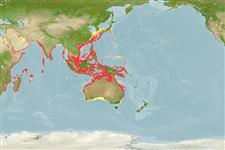Environment: milieu / climate zone / depth range / distribution range
Ökologie
seewasser benthopelagisch; tiefenbereich 30 - 110 m (Ref. 9688). Tropical; 37°N - 43°S, 33°E - 157°E (Ref. 6181)
Indo-West Pacific: Red Sea, Mozambique Channel, Saya de Malha Bank, Chagos Islands, Andaman Sea, northern and southeastern Australia, South China Sea, East China Sea, Tasman Sea, Philippines, and southern Japan.
Size / Gewicht / Alter
Maturity: Lm ? range ? - ? cm
Max length : 90.0 cm TL Männchen/unbestimmt; (Ref. 6181); common length : 50.0 cm TL Männchen/unbestimmt; (Ref. 6181)
Rückenflossenstacheln (insgesamt): 5; Rückenflossenweichstrahlen (insgesamt): 126-144; Afterflossenstacheln 2; Afterflossenweichstrahlen: 47 - 50. Body extremely elongate, compressed and tapering to a point. Pelvic fins reduced to scale-like processes; caudal fin absent. Lateral line running almost straight mid laterally nearer the ventral than the dorsal contour. Color is silvery white becoming silvery gray with dark cloud-like patches after death.
Benthopelagic or pelagic in coastal waters but not found where there is low salinity. Feeds mainly on small fishes, squids and crustaceans. Caught mainly with bottom trawls and sometimes with bag nets, mixed with other trichiurid fishes in southeast Asian countries. Marketed fresh and dried salted in the Philippines.
Life cycle and mating behavior
Geschlechtsreife | Fortpflanzung | Ablaichen | Eier | Fecundity | Larven
Nakamura, I. and N.V. Parin, 1993. FAO Species Catalogue. Vol. 15. Snake mackerels and cutlassfishes of the world (families Gempylidae and Trichiuridae). An annotated and illustrated catalogue of the snake mackerels, snoeks, escolars, gemfishes, sackfishes, domine, oilfish, cutlassfishes,. scabbardfishes, hairtails, and frostfishes known to date. FAO Fish. Synop. 125(15):136 p. (Ref. 6181)
IUCN Rote Liste Status (Ref. 130435)
Bedrohung für Menschen
Harmless
Nutzung durch Menschen
Fischereien: weniger kommerziell
Mehr Information
NamenSynonymeMetabolismusRäuberÖkotoxikologieFortpflanzungGeschlechtsreifeAblaichenSpawning aggregationFecundityEierEientwicklung
ReferenzenAquakulturAquakultur ProfilZuchtlinienGenetikElectrophoresesVererbbarkeitKrankheitenVerarbeitungNutrientsMass conversion
PartnerBilderStamps, Coins Misc.LauteCiguateraGeschwindigkeitSchwimmstilKiemenoberflächeOtolithsGehirngrößeSehfähigkeit
Tools
Zusatzinformationen
Download XML
Internet Quellen
Estimates based on models
Preferred temperature (Ref.
123201): 22.5 - 28.3, mean 27.2 °C (based on 500 cells).
Phylogenetic diversity index (Ref.
82804): PD
50 = 1.0000 [Uniqueness, from 0.5 = low to 2.0 = high].
Bayesian length-weight: a=0.00191 (0.00078 - 0.00466), b=3.11 (2.90 - 3.32), in cm total length, based on LWR estimates for this (Sub)family-body shape (Ref.
93245).
Trophic level (Ref.
69278): 4.2 ±0.58 se; based on food items.
Generation time: 3.8 ( na - na) years. Estimated as median ln(3)/K based on 1
growth studies.
Widerstandsfähigkeit (Ref.
120179): mittel, Verdopplung der Population dauert 1,4 - 4,4 Jahre. (Preliminary K or Fecundity.).
Fishing Vulnerability (Ref.
59153): Moderate vulnerability (38 of 100).
